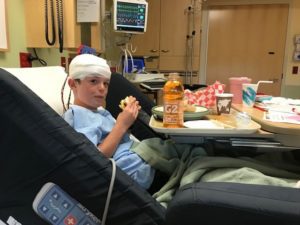
Sometimes life slaps you upside the head and reminds you what is really important. That happened one year ago in our family. It was a Thursday in October. I had a full day of back-to-back meetings at work including over the lunch hour, and was feeling very busy and important. I was rushing to usher the kids out the door to school so I could get on to my demanding schedule, when life had other plans.
The clock ticked toward 8:15 a.m., as I collected my phone and sunglasses at the kitchen desk. The kids were being sloth-like as usual, slow to grab their backpacks and coats. “Let’s go!” I snapped at my son, hovering near me, not making a move to put on his shoes and get out the door. My second son is energetic and distracted, so him ignoring me is nothing new. But something about how he didn’t seem to even register my instructions caused me to turn and look at him curiously.
It’s an image I will never forget. My sweet, spunky 9-year-old was immobile, his arms flexed, eyes glazed, lips stuttering and drooling, and his whole body jerking. I called his name repeatedly and placed my hands lightly on his arms. His gaze was empty, like he wasn’t there. I knew immediately he was having a seizure, which he had never had before, and I had that strange mix of panicked terror and nurturing calm that I think all mothers are blessed with.
Suddenly my work meetings seemed frivolous and inconsequential. I shouted up to my husband to call an ambulance. After a minute or so, my son appeared slowly to return to his body. He couldn’t speak for several minutes, pointed to his mouth and throat, and grabbed a pencil. “Something is wrong…” he scrolled on the back of a piece of scrap paper. I’ll say.
I wanted to rush him directly to the ER, but the pediatrician’s office advised us to come in for a regular appointment, and that sometimes these things just happen. My husband got the other kids to school and the three of us watched TV waiting for the appointment time. I fixated on my son, inspecting him for signs of a seizure. “Mom, stop!” he said, annoyed but also enjoying the attention.
The appointment time arrived. My son sat on the paper-covered table, I explained what happened, and the doctor nodded and took notes. He said we’d likely need to schedule an MRI and a EEG to see if there was anything concerning. But then it happened again, and our treatment plan accelerated. My son started jerking and his eyes looked very far away. The doctor eased him onto his back and said, “Now we need to call an ambulance.” Two unexplained seizures meant this was likely not an anomaly.
The ambulance ride was a thrill for my son as he rattled off questions and looked around. I kept staring at him with a feeling of dread waiting for it to happen again. We got to the ER without incident, but then he had two more seizures of increasing intensity in the emergency room. During one long episode he made moaning sounds, his entire body jerked, and one side of his face twitched rhythmically. It was horrifying to watch, and I felt sick and sad. What was happening to my son?
Eventually he was admitted to American Family Children’s Hospital for two nights. During that time they completed an MRI and ruled out any structural issues (which could have necessitated surgery). He was hooked up to an EEG all night with a video camera monitoring him, and many seizures were captured. Each seizure was a little different, but they always seemed to affect his voice and his upper body. After larger ones, he couldn’t talk regularly for up to half an hour, slurring his words, and nodding off. He seemed spent after each seizure.
After a few fitful, foggy days, we finally got some answers. A neurologist told us our son likely had a variant of Juvenile Myoclonic Epilepsy (JME), and we left with a prescription and a follow-up appointment. Our son had been having small seizures for months or even years, but we hadn’t connected the dots. Several times throughout the summer he had jerked suddenly and spilled his milk. Or seemed to be spaced out and ignoring us. We chalked these up to clumsiness and normal kid behavior. How could we have missed the signs? We took little comfort in the fact that many parents dismiss early symptoms.
The year since has been filled with more questions than answers, but also distinct progress. The first medicine didn’t stop the seizures and made our son irritable. The second also didn’t work, and our son was still having near daily seizures, often at school. It can be worrying if two medicines aren’t effective, with increasing risk that the epilepsy won’t be controllable. But the third medicine seems to be doing the trick. He now very rarely has seizures. The goal of course is to be seizure-free, so we will likely continue to tweak his medication and monitor his response.
We still wonder many things and pepper the doctor with questions. I have come to realize that the brain is really something of a black hole. There is still so much modern medicine does not know. What caused this? We can’t know for sure. It could be genetic. Or it could not be. Will he grow out of this? Maybe. Some people do. Some people don’t. Will he ever be able to drive a car? Maybe. Maybe not.
Even the type of epilepsy he has isn’t clearly defined. It has many characteristics of JME, but doesn’t fit neatly in the box. Our neurologist thinks his seizures are generalized, but some of his colleagues think they are multi-focal. How can they not know? We did genetic testing and they found a gene mutation that could be to blame. But there are people with his type of epilepsy that don’t have the mutation. And there are people who have the mutation who don’t have epilepsy. So it could be meaningless too. There is so much gray area with gray matter!
Throughout this experience I have become thankful for many things. First, we are so lucky to have a world-class hospital right down the street. My son sees a pediatric epileptologist. I didn’t even know that specialty existed. Second, my son is resilient and positive. Far from being discouraged with his diagnosis, he often tells people about it, even when we’d rather he didn’t. Like on airplanes. I admire his outlook and try to learn from it. Third, though I tend to be a black and white person, life exists in the gray. True contentment exists when you surrender to the ambiguous and the unknown. And last, I’m appreciative that sometimes life shakes you up a little and shows you what’s important, because it’s too easy to lose sight of that.












